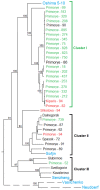The relationship between the structure of the tick-borne encephalitis virus strains and their pathogenic properties
- PMID: 24740396
- PMCID: PMC3989262
- DOI: 10.1371/journal.pone.0094946
The relationship between the structure of the tick-borne encephalitis virus strains and their pathogenic properties
Abstract
Tick-borne encephalitis virus (TBEV) is transmitted to vertebrates by taiga or forest ticks through bites, inducing disease of variable severity. The reasons underlying these differences in the severity of the disease are unknown. In order to identify genetic factors affecting the pathogenicity of virus strains, we have sequenced and compared the complete genomes of 34 Far-Eastern subtype (FE) TBEV strains isolated from patients with different disease severity (Primorye, the Russian Far East). We analyzed the complete genomes of 11 human pathogenic strains isolated from the brains of dead patients with the encephalitic form of the disease (Efd), 4 strains from the blood of patients with the febrile form of TBE (Ffd), and 19 strains from patients with the subclinical form of TBE (Sfd). On the phylogenetic tree, pathogenic Efd strains formed two clusters containing the prototype strains, Senzhang and Sofjin, respectively. Sfd strains formed a third separate cluster, including the Oshima strain. The strains that caused the febrile form of the disease did not form a separate cluster. In the viral proteins, we found 198 positions with at least one amino acid residue substitution, of which only 17 amino acid residue substitutions were correlated with the variable pathogenicity of these strains in humans and they authentically differed between the groups. We considered the role of each amino acid substitution and assumed that the deletion of 111 amino acids in the capsid protein in combination with the amino acid substitutions R16K and S45F in the NS3 protease may affect the budding process of viral particles. These changes may be the major reason for the diminished pathogenicity of TBEV strains. We recommend Sfd strains for testing as attenuation vaccine candidates.
Conflict of interest statement
Figures





References
-
- Zlobin VI (2005) [Tick-borne encephalitis in the Russian Federation: state-of-the-art and prevention policy]. Vopr Virusol 50(3): : 26–32. Russian. - PubMed
-
- Charrel RN, Attoui H, Butenko AM, Clegg JC, Deubel V, et al. (2004) Tick-borne virus diseases of human interest in Europe. Clin Microbiol Infect 10(12): 1040–55. - PubMed
-
- Suss J (2008) Tick-borne encephalitis in Europe and beyond—the epidemiological situation as of 2007. Euro Surveill 13(26): pii = 18916 - PubMed
-
- Heinz FX, Collett MS, Purcell RH, Gould EA, Howard CR, et al.. (2000) Family Flaviviridae. In: MHVR, Fauquet CM, Bishop DHL, Carstens E, Estes MK, et al... eds. Virus Taxonomy 7th International committee for the Taxonomy of Viruses. San Diego: Academic Press. pp. 859–878.
-
- Gritsun TS, Lashkevich VA, Gould EA (2003) Tick-borne encephalitis. Antiviral Res 57(1-2): 129–46. - PubMed
Publication types
MeSH terms
Substances
LinkOut - more resources
Full Text Sources
Other Literature Sources

